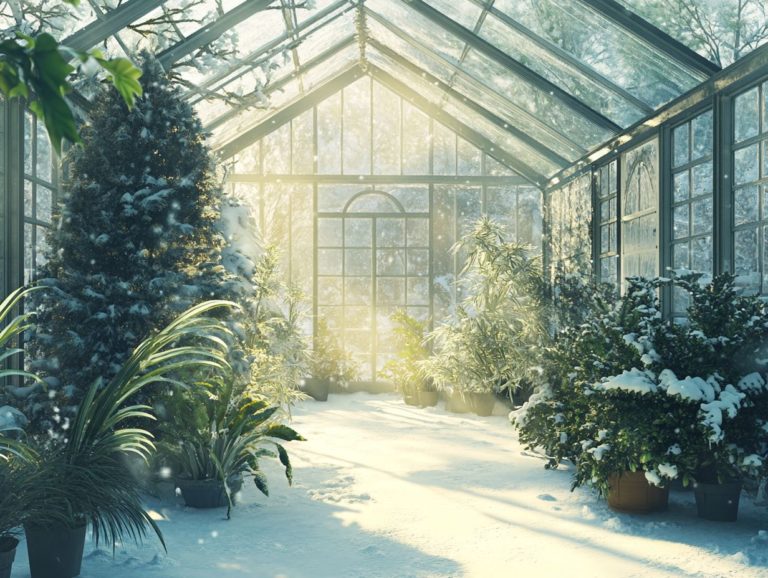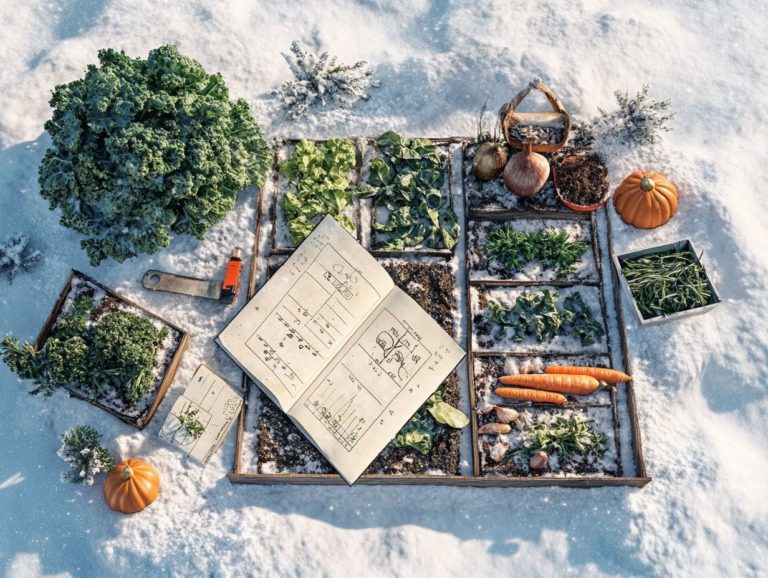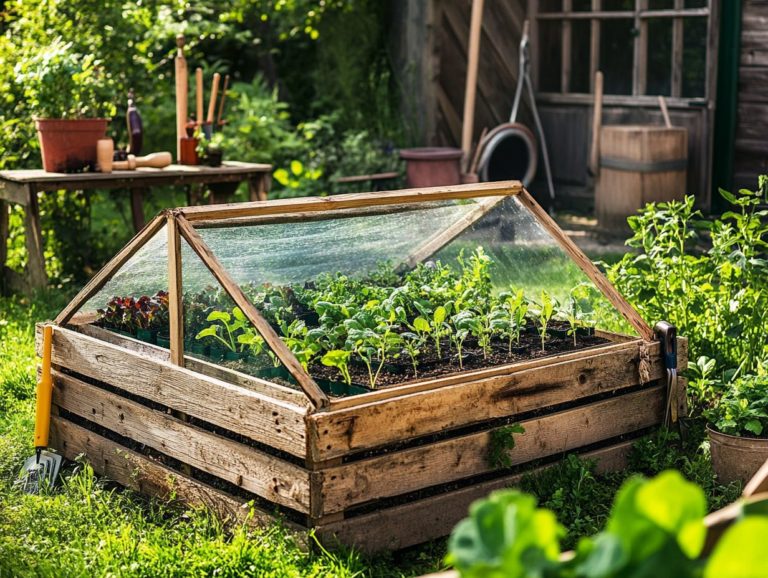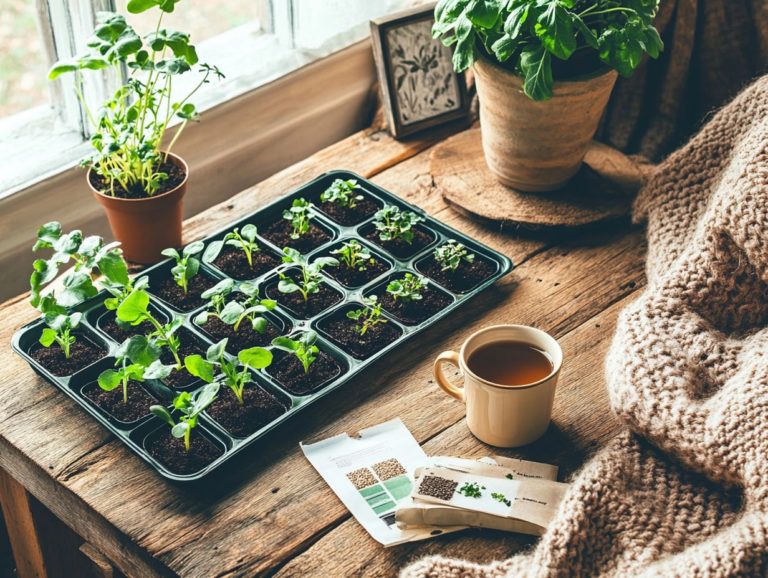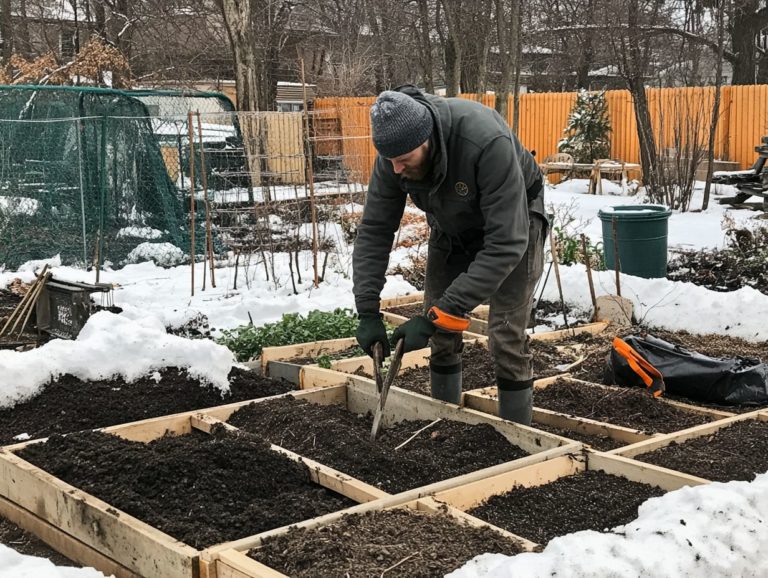5 Essential Winter Gardening Tips for Success
Winter is coming. You might be tempted to put away your gardening tools, but winter gardening offers a chance to nurture resilient plants that thrive in the cold.
This article shares five essential tips for winter gardening. You ll learn about choosing cold-hardy plants, preparing your soil, and protecting your garden from frost.
Explore the benefits of winter gardening and the best vegetables to grow. Learn practical strategies to keep your garden vibrant all season long. Embrace the beauty of winter gardening! Discover how you can grow fresh vegetables even in the coldest months.
Contents
- Key Takeaways:
- 1. Choose Cold-Hardy Plants
- 2. Prepare Your Soil for Winter
- 3. Protect Your Plants from Frost and Snow
- 4. Provide Adequate Watering and Drainage
- 5. Use Mulch to Insulate Your Garden
- What Are the Benefits of Winter Gardening?
- How Can You Prepare Your Garden for Winter?
- Frequently Asked Questions
- What are the 5 essential winter gardening tips for success?
- How do I choose the right plants for winter gardening?
- What should I do to prepare the soil for winter gardening?
- How can I protect my plants from harsh winter weather?
- Is watering important during winter gardening?
- How can I plan for the next growing season while winter gardening?
Key Takeaways:
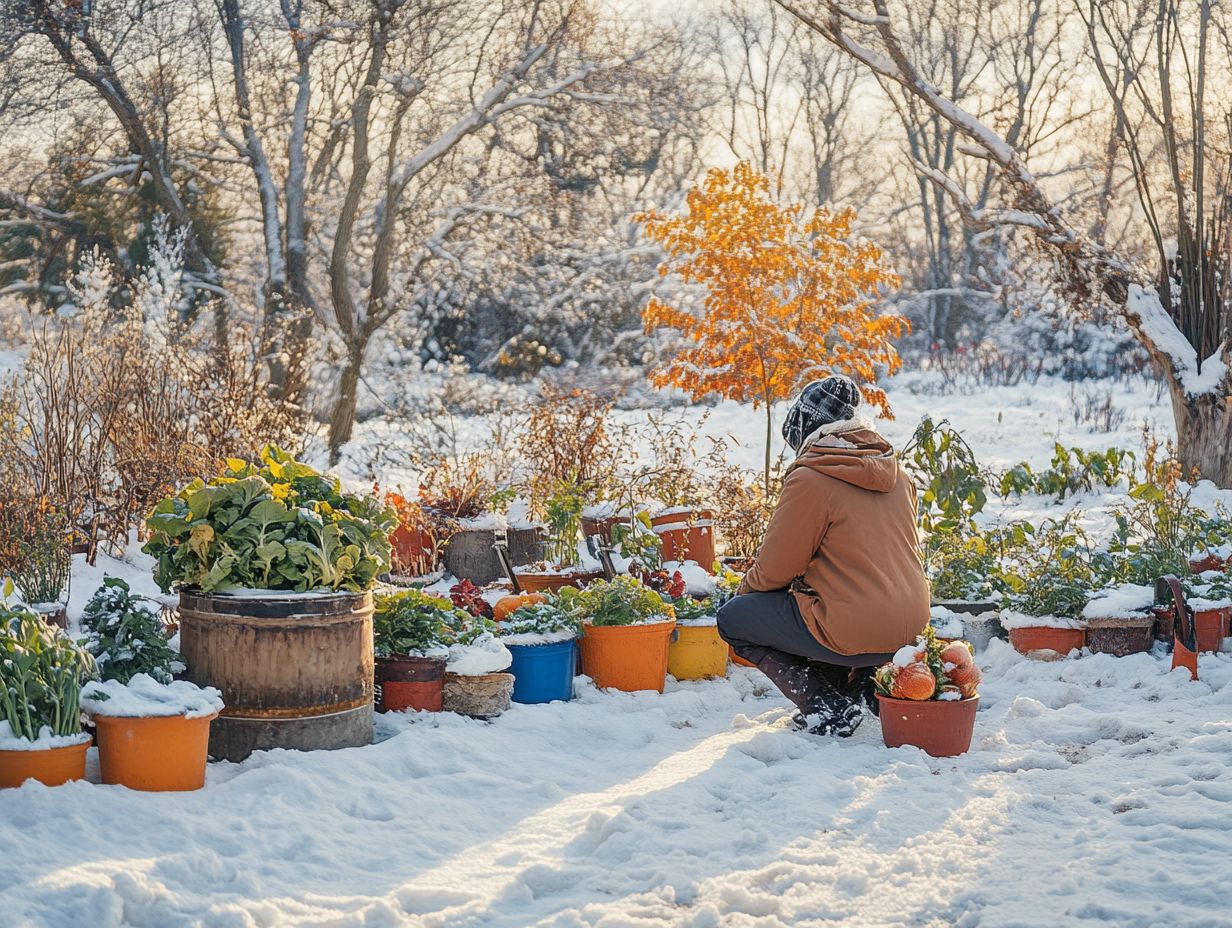
- Choose cold-hardy plants to enjoy winter vegetables.
- Prepare your soil now for a healthy garden.
- Shield your plants to keep them safe this winter.
1. Choose Cold-Hardy Plants
Choosing cold-hardy plants is essential for your successful winter gardening. You can enjoy fresh vegetables even during the coldest months. By selecting varieties such as kale, spinach, carrots, and broccoli, you can maximize your harvest while ensuring that your vegetable garden thrives across various hardiness zones. To enhance your winter gardening experience, consider using the 5 must-have tools for winter gardening.
These resilient plants withstand temperatures that challenge more delicate varieties. For instance, kale and spinach not only provide excellent sources of vitamins but also sweeten in flavor after frost, enhancing your winter dishes.
Carrots can be left in the ground until you need them, minimizing waste and offering a fresh supply even during harsh weather. Embracing these robust choices contributes to sustainable gardening practices. Cold-hardy plants require less intensive care and can naturally fend off pests.
Ultimately, these plants support sustainable practices and enable you to reap the rewards of your efforts all year round, including a winter harvest of fresh vegetables.
2. Prepare Your Soil for Winter
Preparing your soil for winter is essential for maintaining its health. Effective composting plays a crucial role in this process, especially for planning your garden successfully.
Incorporating rich compost into your soil adds vital organic matter. This enhances soil structure and promotes microbial activity, supporting nutrient retention. Using soil insulation techniques, such as mulch or cover crops, protects your soil from harsh winter conditions and regulates temperature.
With the right preparation, you can evaluate your soil s health. Choose crops better suited for spring planting, setting the stage for robust growth and higher yields in the upcoming season.
3. Protect Your Plants from Frost and Snow
To ensure your plants thrive through frost and snow, use protective coverings like cold frames, row covers, and hoop houses. These structures help you create mini climates that shield your crops from winter.
They provide a barrier against biting winds and frigid temperatures, retaining humidity and warmth necessary for growth. If you prefer a hands-on approach, consider making DIY cloches from plastic bottles or other items; they can effectively protect seedlings.
Sharing resources and knowledge with the gardening community cultivates wellness and connectivity. This encourages fellow gardeners to experiment with various coverings and techniques, enriching everyone’s gardening experience and leading to more resilient harvests.
4. Provide Adequate Watering and Drainage
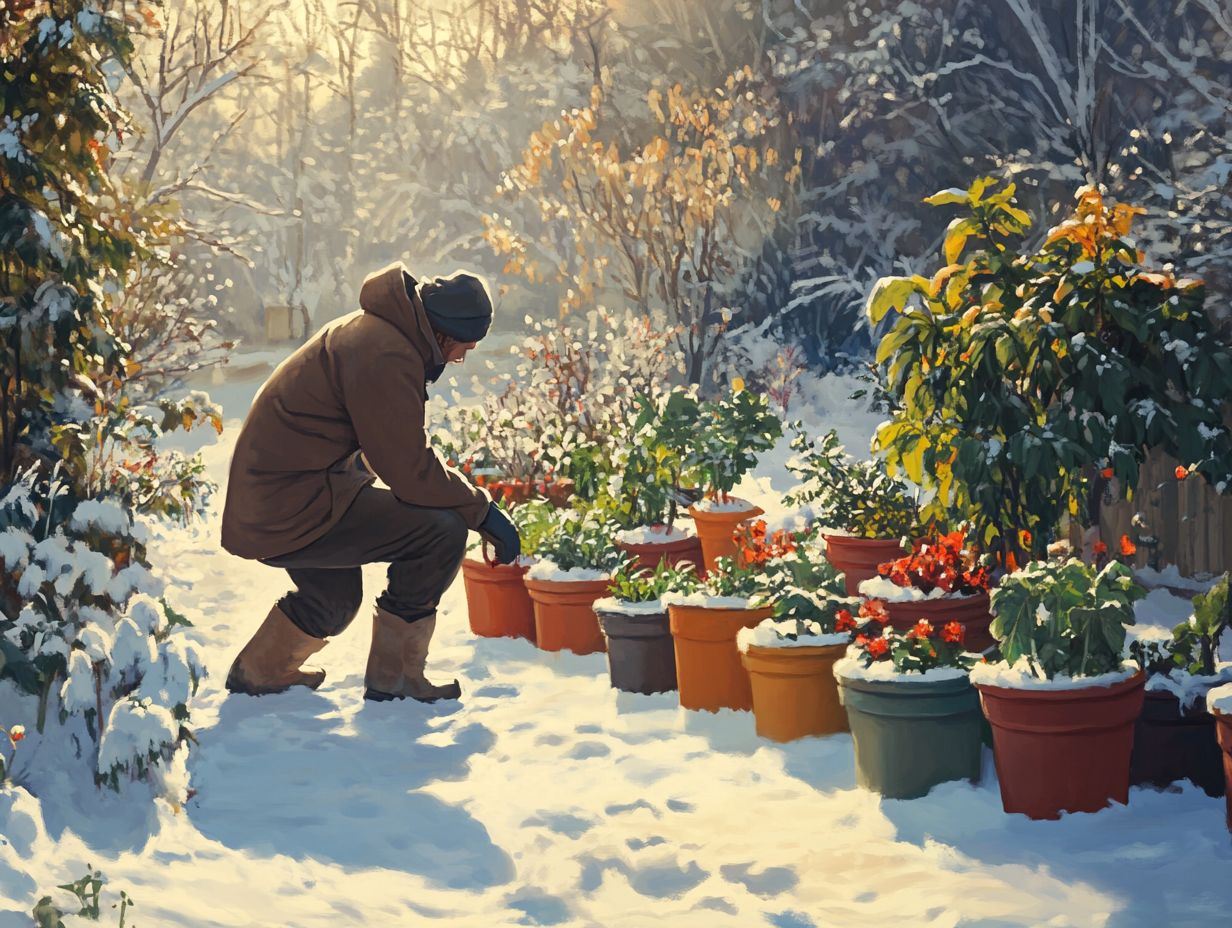
Watering and drainage are crucial for winter gardening. Even in cold months, your plants need moisture, but avoid waterlogged soil as it can lead to root rot. For more insights, check out these 5 tips for indoor winter crop gardening.
Check soil wetness often, especially when temperatures drop. You might think winter means less water is needed, but many plants are still active, just at a slower pace.
Regularly test moisture levels with a tool or by feeling the soil. Using drip irrigation or soaker hoses delivers water directly to roots without excess runoff.
Raised beds and organic mulch greatly improve drainage. They help retain moisture while preventing harmful saturation.
5. Use Mulch to Insulate Your Garden
Mulch acts as insulation for your garden in winter. It maintains soil temperature and moisture while protecting roots from freezing.
Different types of mulch can enhance these benefits. Straw is lightweight and traps heat, while fallen leaves enrich the soil as they break down. Wood chips create a durable barrier, suppressing weeds and retaining water.
Mulch also boosts soil health by supporting beneficial microorganisms and worms. This is vital for organic gardening, where ecosystem balance is essential.
What Are the Benefits of Winter Gardening?
Winter gardening offers many advantages. You can harvest fresh vegetables in the off-season and support ecological functions that enhance soil biodiversity.
It extends your growing season and improves soil health through cover cropping and composting. These methods replenish nutrients and create a thriving ecosystem.
Growing food in winter promotes community wellness by making fresh produce accessible and supporting nutrition. Plus, gardening provides psychological benefits, offering a soothing escape from seasonal stress.
What Are the Best Plants to Grow in the Winter?
The best winter garden plants are cold-hardy vegetables like kale, spinach, and broccoli. They keep your garden productive even in cold weather.
Consider adding carrots, which sweeten with frost, and garlic, planted in fall for a spring harvest. These crops thrive in freezing temperatures and provide essential nutrients.
Preparation is key for growing winter crops. Enrich the soil with good drainage and organic matter. Additionally, having the right supplies is crucial; consider using essential tools for winter gardening success. Check for pests regularly and use mulch to maintain soil temperature and moisture for a rewarding harvest.
How Can You Prepare Your Garden for Winter?
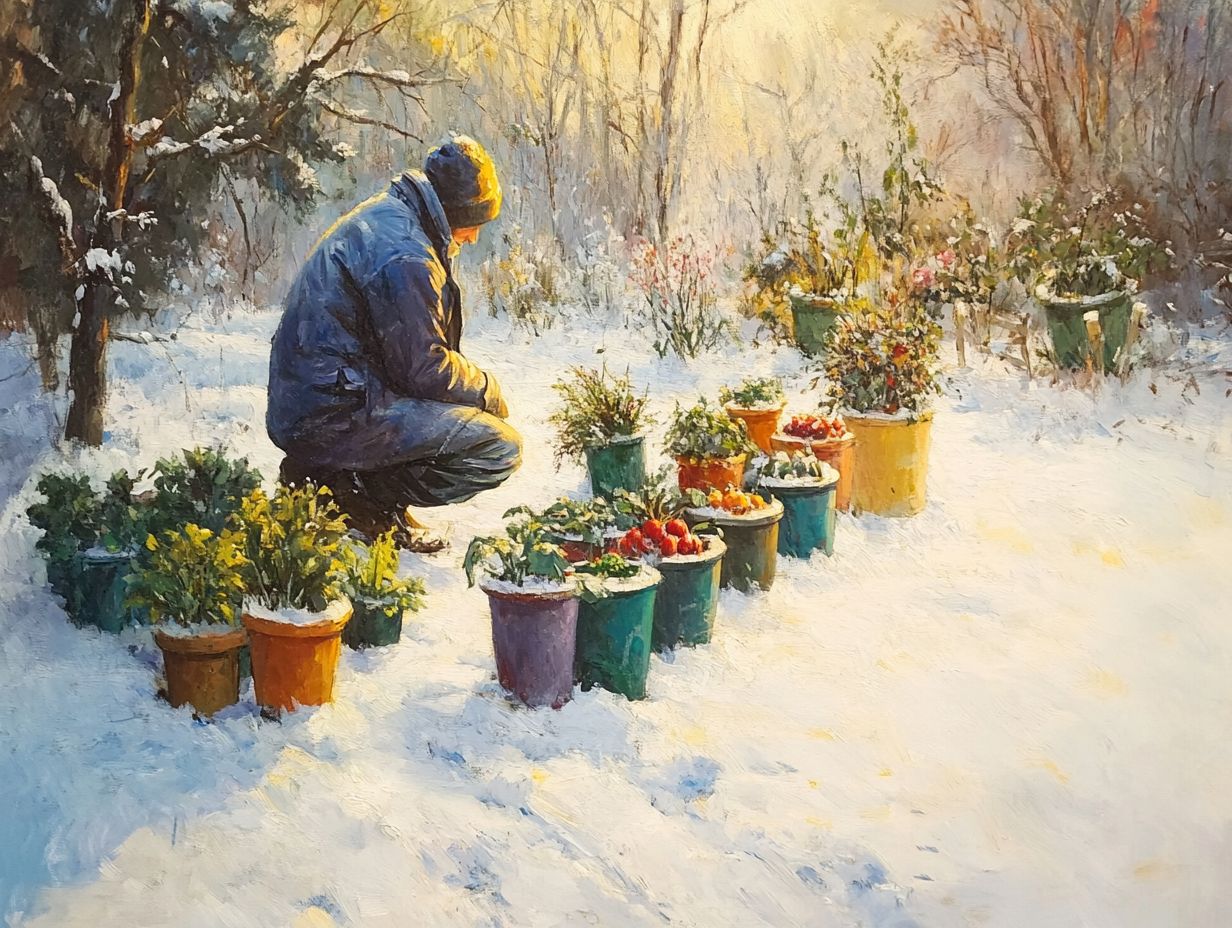
Preparing your garden for winter is an art that requires a strategic approach. It encompasses everything from enhancing soil health to selecting the right winter gardening hacks for success and resources. This meticulous process involves assessing soil conditions and enriching it with organic matter. It’s also essential to choose plants that can withstand colder temperatures.
You ll find it beneficial to understand protective measures, such as mulching and using frost covers, to safeguard your vulnerable plants. Familiarizing yourself with local climate considerations will enable you to make informed choices about the plant varieties that will thrive in winter.
If you’re eager to dive deeper, you’ll discover a wealth of knowledge in gardening books, online forums, and local agricultural extensions. Additionally, you can explore 5 tips for successful winter sowing that offer valuable insights and best practices, guiding you through your winter preparations with confidence and expertise.
What Are the Best Ways to Protect Plants from Frost and Snow?
To safeguard your plants from frost and snow, consider employing effective gardening techniques like row covers, hoop houses, and cloches. These methods provide essential protection against harsh weather conditions.
Timing is everything. Deploy these protective measures just before a frost event to ensure their maximum effectiveness. For example, place row covers over delicate plants in the late afternoon, right when temperatures start to dip, to ensure they receive adequate insulation overnight.
Adapting these strategies to your local climate is also vital. Choose materials that align with your specific climate zone, where your plants can survive winter temperatures. In milder regions, lightweight row covers might do the trick, while harsher climates may require thicker materials or robust hoop houses to endure heavier snowfall. Utilizing cold frames can also be beneficial for growing season extension.
How Often Should You Water Your Garden in the Winter?
Establishing an appropriate watering schedule for your winter garden is essential. Even during the colder months, plants still require moisture, but be careful to avoid overwatering when temperatures drop. For more insights, check out these tips for sustainable winter gardening.
To effectively manage soil moisture, check the top inch of soil regularly. If it feels dry to the touch, it s likely time for a drink. On particularly cold or windy days, the demand for water decreases, making it crucial to adjust your watering frequency based on current weather conditions.
If there has been recent rainfall or if temperatures dip below freezing, consider holding off on watering for a few extra days. For those cultivating winter vegetables such as kale, spinach, carrots, and broccoli, a deep but infrequent watering strategy is usually best. This approach ensures that the roots remain hydrated without waterlogging the soil, striking the perfect balance for thriving plants.
What Types of Mulch Are Best for Winter Gardening?
The finest mulches for winter gardening are organic materials like straw, shredded leaves, and wood chips. These options not only provide superb insulation but also enhance soil health.
By laying down a protective blanket over the soil, these mulches help maintain a stable temperature while preventing harmful frost from penetrating. This benefits your plants as they prepare for dormancy. Straw, in particular, is a lightweight champion that allows for air circulation while retaining essential moisture. Shredded leaves are a dual-purpose delight they break down over time to enrich the soil and retain warmth during the cooler months. Organic gardening practices, like using wood chips, offer a robust cover that shields the soil from the harsh conditions of winter.
To apply mulch effectively, aim for a layer that’s about 2-4 inches thick around your plants. Just remember not to pile it up against the stems; this prevents rot and promotes healthy growth when spring arrives.
Frequently Asked Questions
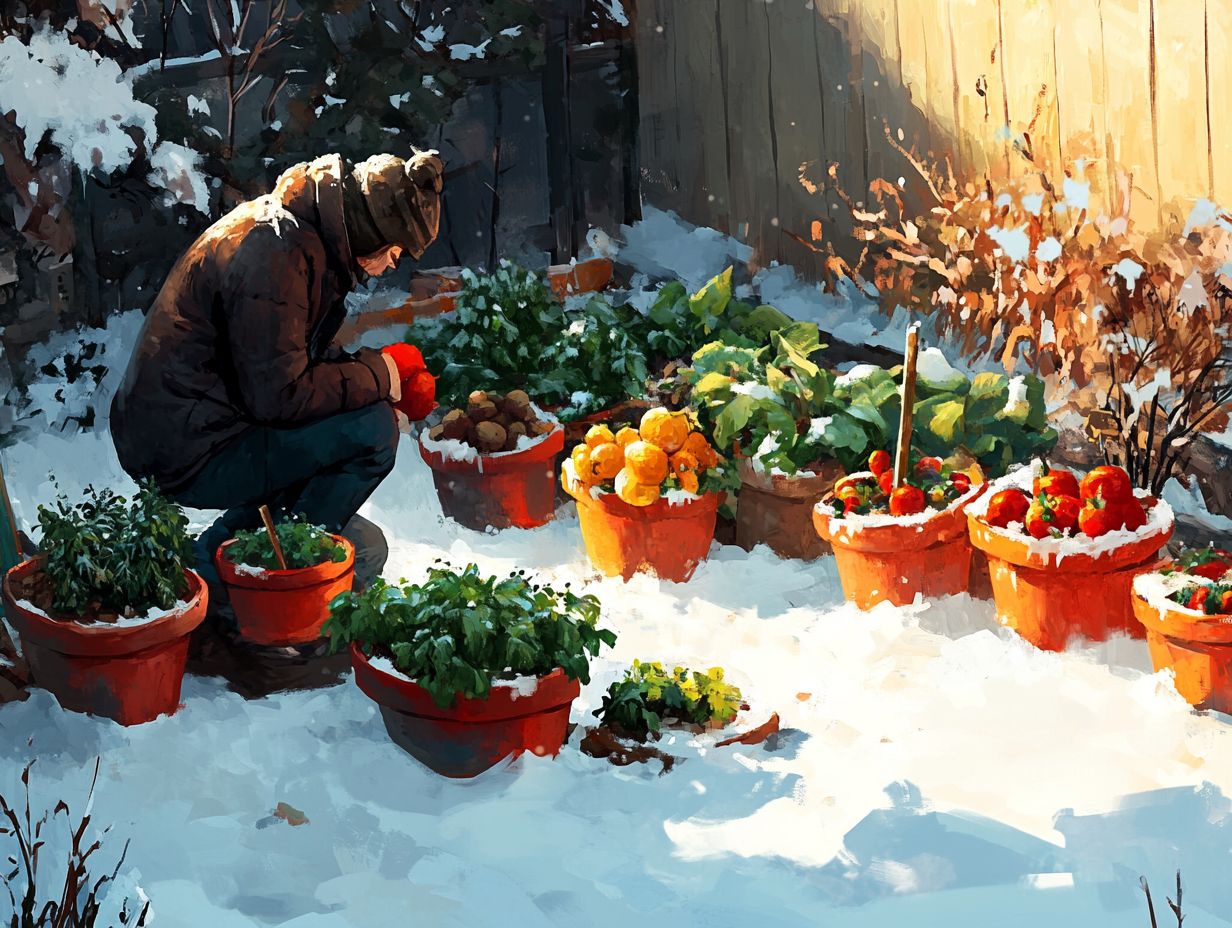
Get ready! Start your winter gardening preparations today to ensure a thriving garden come spring!
What are the 5 essential winter gardening tips for success?
Here are the 5 essential winter gardening tips for success:
1. Choosing the right plants. 2. Preparing the soil. 3. Protecting plants from harsh weather. To ensure success, follow these 5 steps to a thriving winter vegetable garden. Don’t forget to provide adequate water and nutrients, and plan for the next growing season.
How do I choose the right plants for winter gardening?
Choose strong plants that can withstand cold temperatures, such as evergreens, winter vegetables, and winter-blooming flowers. To successfully navigate the season, consider the top challenges of winter gardening and research which plants are suitable for your specific climate and gardening zone to enhance your kitchen gardening efforts.
What should I do to prepare the soil for winter gardening?
Start by removing debris and weeds from the garden bed. Add a layer of compost or mulch to improve soil structure and add nutrients.
How can I protect my plants from harsh winter weather?
Cover your plants with mulch or a protective blanket to keep them cozy! Use protective coverings like PVC pipe structures for extra defense. Create a windbreak with barriers or strategically placed plants to shield against strong winds.
Is watering important during winter gardening?
Yes, watering is still important during winter gardening. Keep an eye on the soil! Water when it s dry to ensure your plants stay healthy through winter.
How can I plan for the next growing season while winter gardening?
Use the winter months to plan for the next growing season. This can include ordering seeds indoors, creating a garden layout, and organizing gardening tools and supplies.
Explore gardening resources for effective crop selection strategies.

